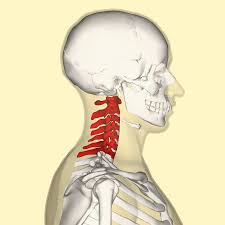It appears that you’re referring to the cervical spine, which is the upper portion of the vertebral column located in the neck region. The cervical spine consists of seven vertebrae numbered from C1 to C7, starting from the top.

Anatomy of the Cervical Spine:
The cervical spine is designed to provide support, stability, and flexibility to the head and neck while allowing for various movements such as bending, twisting, and turning. Each cervical vertebra consists of a cylindrical body, a bony arch, and various processes that serve as attachment points for ligaments, muscles, and tendons. Intervertebral discs, located between adjacent vertebrae, act as shock absorbers and provide cushioning to the spine during movement.
Functions of the Cervical Spine:
Support: The cervical spine supports the weight of the head and helps maintain proper alignment of the head and neck.
Mobility: The cervical spine allows for a wide range of movements, including flexion (forward bending), extension (backward bending), lateral flexion (side bending), and rotation (turning).
Protection: The cervical spine protects the spinal cord, which runs through the spinal canal formed by the vertebral arches, as well as the nerves that branch off from the spinal cord and innervate various parts of the body.
Common Conditions and Injuries of the Cervical Spine:
Neck Strain: Neck strain, also known as cervical strain, is a common injury resulting from overuse, poor posture, sudden movements, or trauma that causes stretching or tearing of the muscles and ligaments in the neck.
Cervical Disc Herniation: A cervical disc herniation occurs when the soft inner core of an intervertebral disc protrudes through the tough outer layer, irritating nearby nerves and causing symptoms such as neck pain, arm pain, numbness, or weakness.
Cervical Radiculopathy: Cervical radiculopathy is a condition caused by compression or irritation of a nerve root in the cervical spine, often due to a herniated disc, bone spurs (osteophytes), or spinal stenosis. Symptoms may include neck pain, arm pain, numbness, tingling, or weakness in the affected arm or hand.
Cervical Spondylosis: Cervical spondylosis, also known as neck arthritis or cervical osteoarthritis, is a degenerative condition characterized by the wear and tear of the cervical spine joints, intervertebral discs, and surrounding structures. Symptoms may include neck pain, stiffness, decreased range of motion, and headaches.
Cervical Spinal Stenosis: Cervical spinal stenosis is a narrowing of the spinal canal in the cervical spine, leading to compression of the spinal cord or nerve roots. Symptoms may include neck pain, arm pain, numbness, weakness, or difficulty walking.
Diagnosis and Treatment:
Diagnosis of cervical spine conditions typically involves a combination of medical history, physical examination, imaging studies (such as X-rays, MRI, or CT scans), and sometimes specialized tests such as electromyography (EMG) or nerve conduction studies.
Treatment of cervical spine conditions depends on the specific diagnosis, severity of symptoms, and individual factors. Options may include:
Conservative Treatments: Conservative treatments for cervical spine conditions may include rest, activity modification, physical therapy, stretching and strengthening exercises, heat or cold therapy, over-the-counter pain medications, and epidural steroid injections.
Medications: Medications such as nonsteroidal anti-inflammatory drugs (NSAIDs), muscle relaxants, neuropathic pain medications, or oral steroids may be prescribed to alleviate pain and inflammation.
Cervical Traction: Cervical traction therapy may be used to gently stretch the cervical spine and relieve pressure on compressed nerves or discs.
Surgical Interventions: In cases of severe or refractory symptoms, surgical interventions such as discectomy, laminectomy, cervical fusion, or artificial disc replacement may be considered to decompress nerves, stabilize the spine, or address structural abnormalities.
Lifestyle Modifications: Adopting healthy lifestyle habits such as maintaining good posture, avoiding prolonged sitting or standing, using proper ergonomics, and engaging in regular exercise can help prevent or manage cervical spine conditions.





